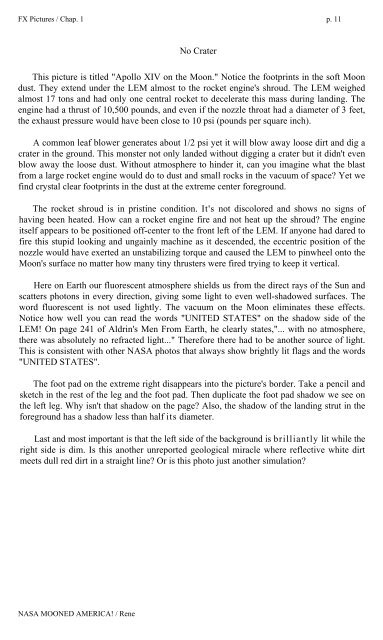Rene-NASA-Mooned-America
Rene-NASA-Mooned-America
Rene-NASA-Mooned-America
Create successful ePaper yourself
Turn your PDF publications into a flip-book with our unique Google optimized e-Paper software.
FX Pictures / Chap. 1 p. 11<br />
No Crater<br />
This picture is titled "Apollo XIV on the Moon." Notice the footprints in the soft Moon<br />
dust. They extend under the LEM almost to the rocket engine's shroud. The LEM weighed<br />
almost 17 tons and had only one central rocket to decelerate this mass during landing. The<br />
engine had a thrust of 10,500 pounds, and even if the nozzle throat had a diameter of 3 feet,<br />
the exhaust pressure would have been close to 10 psi (pounds per square inch).<br />
A common leaf blower generates about 1/2 psi yet it will blow away loose dirt and dig a<br />
crater in the ground. This monster not only landed without digging a crater but it didn't even<br />
blow away the loose dust. Without atmosphere to hinder it, can you imagine what the blast<br />
from a large rocket engine would do to dust and small rocks in the vacuum of space Yet we<br />
find crystal clear footprints in the dust at the extreme center foreground.<br />
The rocket shroud is in pristine condition. It's not discolored and shows no signs of<br />
having been heated. How can a rocket engine fire and not heat up the shroud The engine<br />
itself appears to be positioned off-center to the front left of the LEM. If anyone had dared to<br />
fire this stupid looking and ungainly machine as it descended, the eccentric position of the<br />
nozzle would have exerted an unstabilizing torque and caused the LEM to pinwheel onto the<br />
Moon's surface no matter how many tiny thrusters were fired trying to keep it vertical.<br />
Here on Earth our fluorescent atmosphere shields us from the direct rays of the Sun and<br />
scatters photons in every direction, giving some light to even well-shadowed surfaces. The<br />
word fluorescent is not used lightly. The vacuum on the Moon eliminates these effects.<br />
Notice how well you can read the words "UNITED STATES" on the shadow side of the<br />
LEM! On page 241 of Aldrin's Men From Earth, he clearly states,"... with no atmosphere,<br />
there was absolutely no refracted light..." Therefore there had to be another source of light.<br />
This is consistent with other <strong>NASA</strong> photos that always show brightly lit flags and the words<br />
"UNITED STATES".<br />
The foot pad on the extreme right disappears into the picture's border. Take a pencil and<br />
sketch in the rest of the leg and the foot pad. Then duplicate the foot pad shadow we see on<br />
the left leg. Why isn't that shadow on the page Also, the shadow of the landing strut in the<br />
foreground has a shadow less than half its diameter.<br />
Last and most important is that the left side of the background is brilliantly lit while the<br />
right side is dim. Is this another unreported geological miracle where reflective white dirt<br />
meets dull red dirt in a straight line Or is this photo just another simulation<br />
<strong>NASA</strong> MOONED AMERICA! / <strong>Rene</strong>


